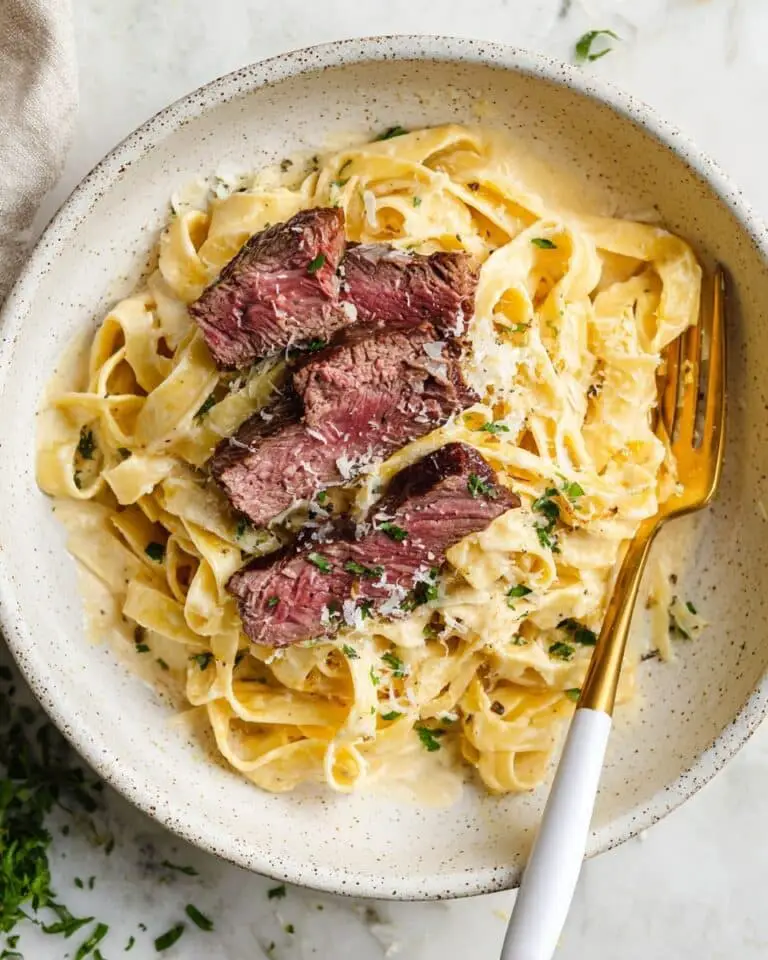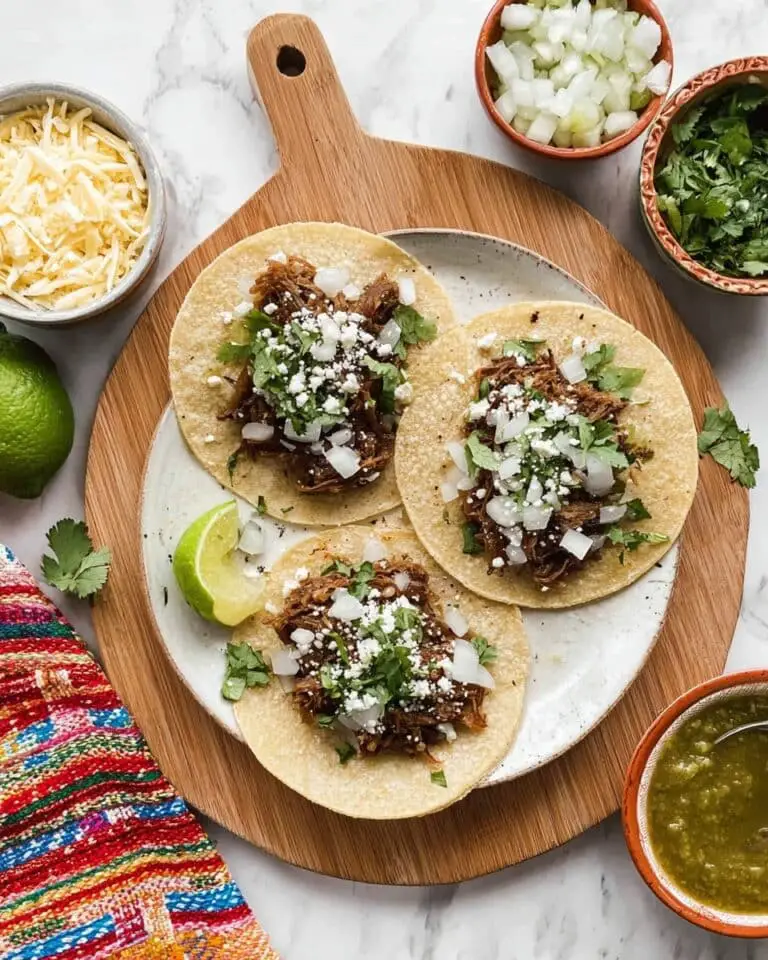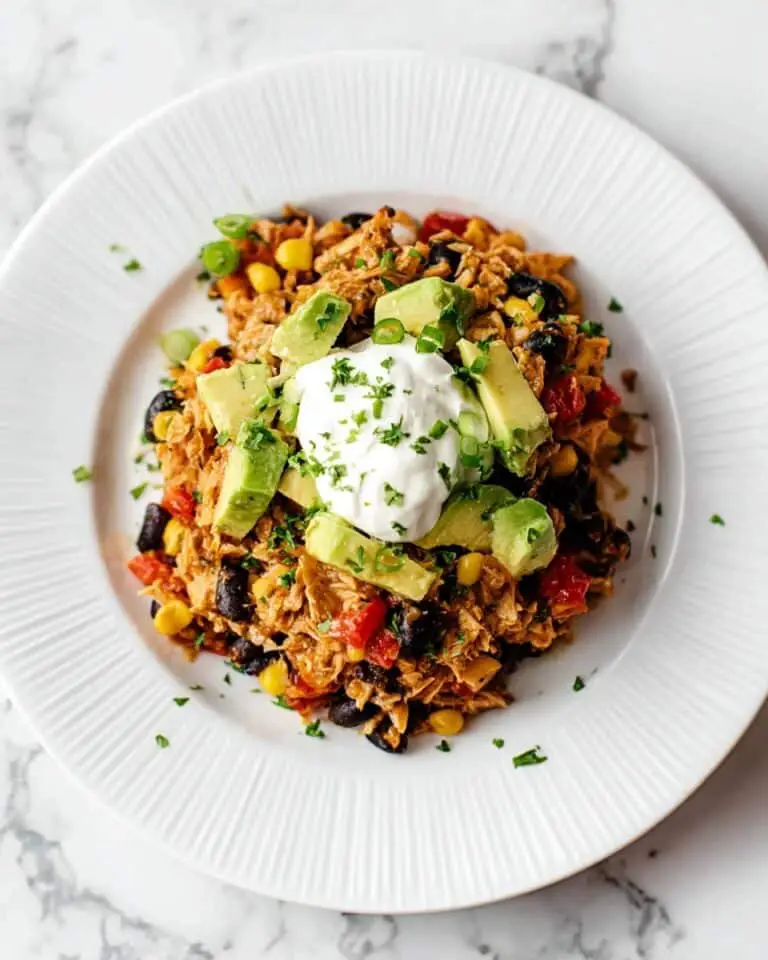Short Description
A vibrant and nutritious bowl full of colorful vegetables, perfectly cooked rice, and a sunny-side-up egg, topped with spicy gochujang and sesame flavors. Bibimbap is an easy, plant-forward dish packed with taste and texture.
Why You’ll Love This Recipe
You’ll love this Bibimbap bowl for its lively mix of flavors and textures—from the crisp veggies and nutty sesame oil to the creamy yolk and zesty gochujang. It’s customizable, satisfying, and comes together in under 30 minutes—ideal for a wholesome weeknight meal.
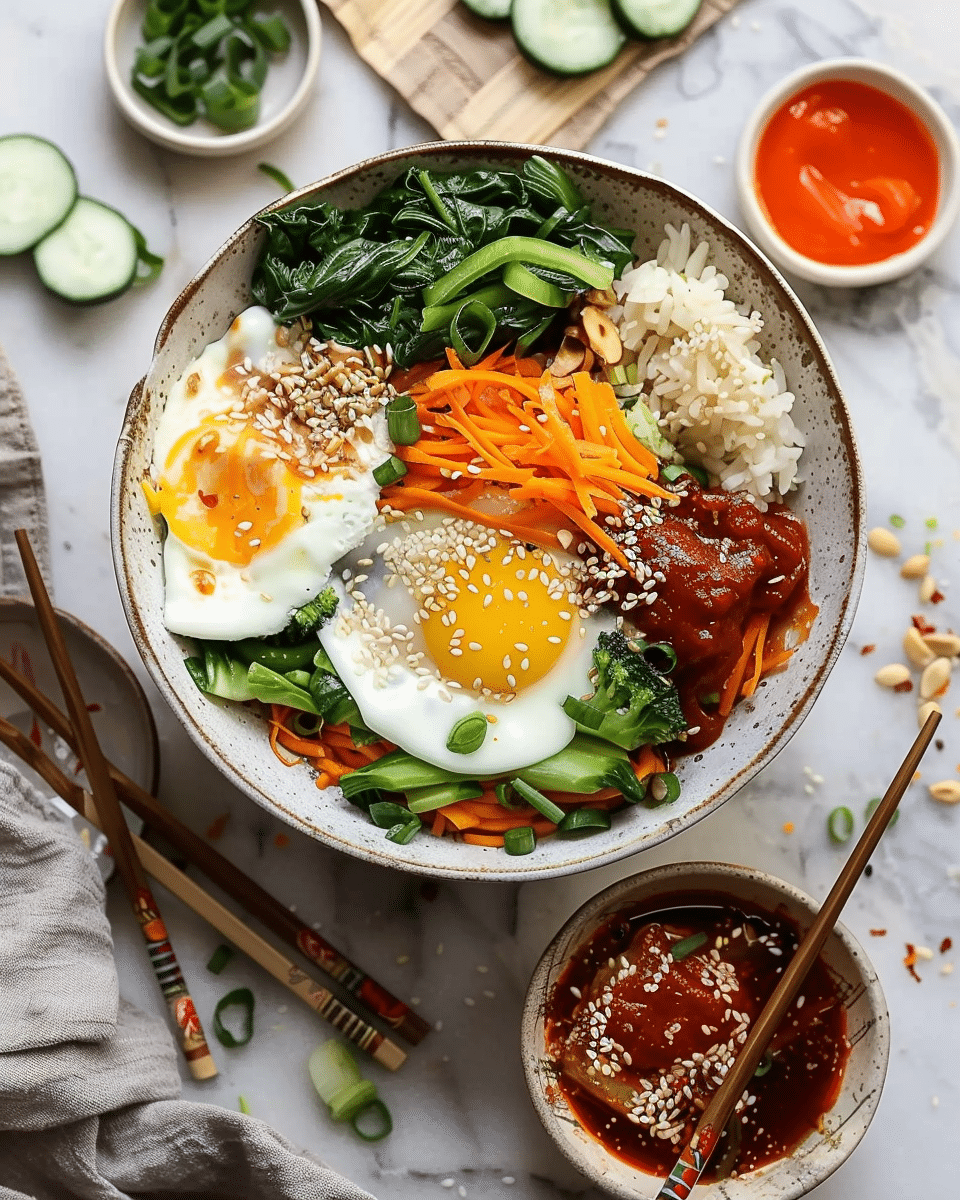
Ingredients
(Tip: You’ll find the full list of ingredients and measurements in the recipe card below.)
• 4 cups cooked short-grain white rice
• 4 eggs
• 1 cup baby spinach
• 1 cup shredded carrots
• 1 cup cooked edamame
• 1 small cucumber, thinly sliced
• 2 tablespoons sesame oil
• 4 tablespoons gochujang (Korean chili paste)
• 1 tablespoon soy sauce
• 1 teaspoon toasted sesame seeds
• Salt, to taste
Directions
- Cook the Veggies
- Heat about 1 tablespoon of sesame oil in a skillet over medium heat. Add the spinach with a pinch of salt and sauté just until wilted. Remove and set aside.
- In the same pan, add shredded carrots and sauté for 1–2 minutes until slightly tender but still crisp. Remove and set aside.
- Ensure edamame is cooked and cucumber is sliced—these need no cooking and add freshness and texture.
- Fry the Eggs
- Wipe the skillet clean and add a splash of oil. Fry four eggs sunny‑side‑up, letting the yolks remain runny―great for mixing into the warm rice.
- Build the Bowls
- Divide cooked rice evenly into four bowls.
- Arrange small piles of spinach, carrots, cucumber, and edamame around the rice.
- Place a fried egg in the center of each bowl.
- Add Sauce & Serve
- Drizzle each bowl with about 1 tablespoon gochujang and a little soy sauce (proportion to taste).
- Finish with a few drops of sesame oil and a sprinkle of toasted sesame seeds.
- Enjoy
- Mix everything well before eating—the yolk blends with the sauce and rice for a rich, flavorful “big mess” of deliciousness.
Servings And Timing
Yields 4 bowls.
Prep time: ~10 minutes (chopping and gathering ingredients).
Cook time: ~10–15 minutes.
Total time: ~20–25 minutes.
Variations
- Protein Options: Add marinated tofu, grilled chicken, or bulgogi beef.
- Extra Veggies: Include mushrooms, bean sprouts, zucchini, or spinach sautéed separately.
- Heat Level: Adjust gochujang quantity to scale spiciness; serve additional chili paste on the side.
- Sauce Twist: Add a drizzle of sesame mayo or sriracha mayo for a creamier topping.
- Vegan Version: Omit the egg or substitute with pan-fried tofu slices.
Storage/Reheating
Store components separately in airtight containers in the fridge for up to 2 days.
Reheat rice and veggies in a skillet or microwave, and fry eggs fresh just before serving to maintain yolk quality.
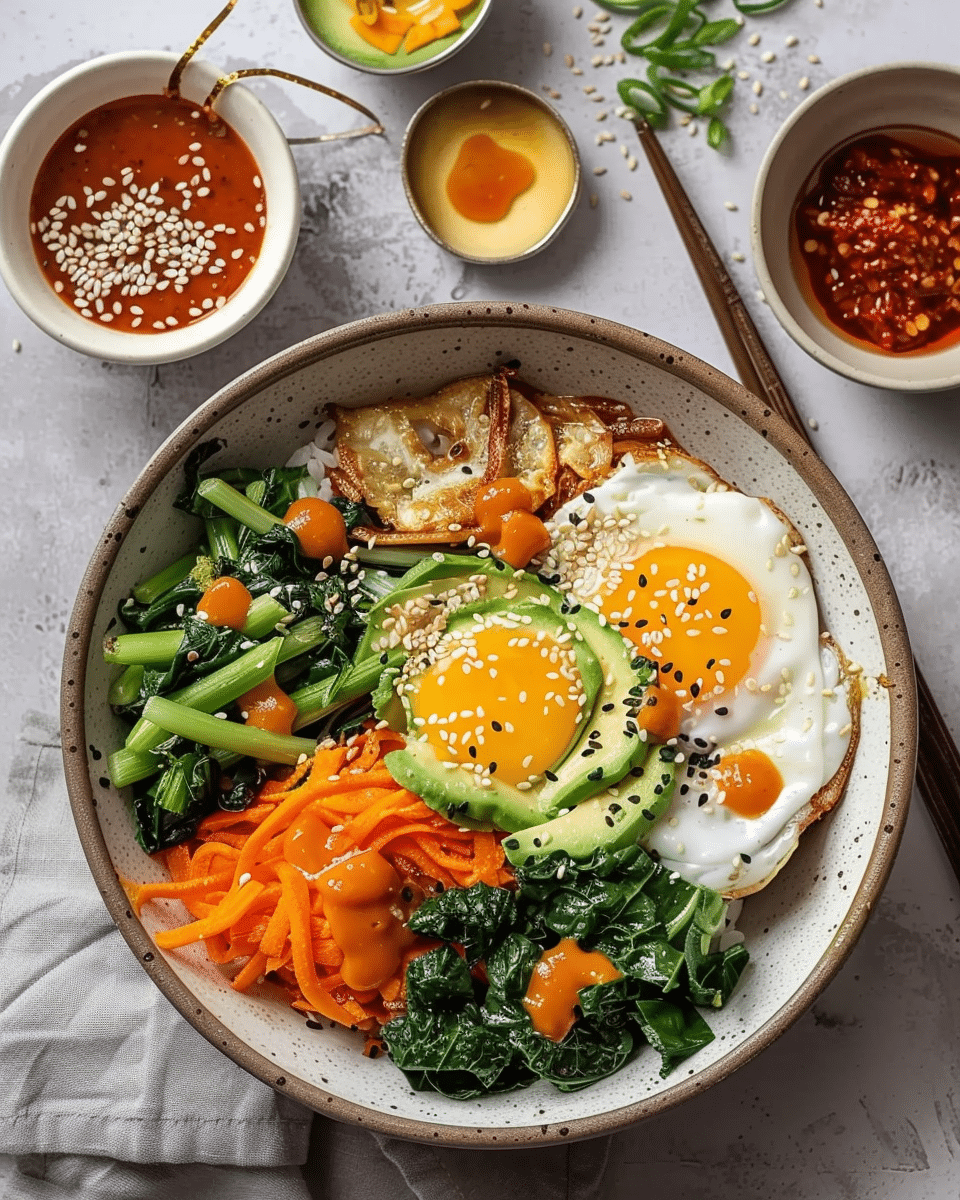
FAQs
Can I use brown rice instead of white rice?
Yes. Brown rice works well—you may need to adjust cooking time or water ratio if cooking from scratch.
Can I prep the veggies in advance?
Yes. Sauté the spinach and carrots ahead, then refrigerate. Assemble bowls just before eating for best freshness.
Is this gluten-free?
Soy sauce contains gluten. Use tamari or a gluten‑free soy sauce to make this recipe gluten‑free.
Can I make this vegan?
Yes. Omit the egg or replace with seasoned tofu or a vegan fried egg alternative.
What if I don’t like spicy food?
Reduce the gochujang or serve it on the side. You can also mix in a mild chili sauce or omit completely.
Can I add protein like mushrooms or meat?
Absolutely. Sauté mushrooms or cook strips of chicken, beef, or tofu to add at assembly.
Will this keep well for meal prep?
To preserve texture, store rice, veggies, and protein separately and assemble bowls fresh. Mix gochujang and toppings just before serving.
How spicy is gochujang?
Gochujang brings moderate heat and deep umami-sweet flavor. Adjust to your taste or choose mild or hot varieties accordingly.
Any garnish suggestions?
Try toasted nori strips, sliced scallions, or a sprinkle of kimchi for crunch and tang.
Why is the yolk kept runny?
The runny yolk adds richness when mixed into rice and sauce, creating a creamy, cohesive bowl.
Conclusion
Korean Veggie Bibimbap Bowls are a colorful, nourishing meal loaded with veggies, warm rice, spicy sauce, and creamy yolk. Easy to customize and quick to assemble, they’re perfect for a satisfying lunch or dinner. Mix it up with proteins or extra toppings to match your mood—and dig into a bowl that truly celebrates flavor and balance.
Print
Korean Veggie Bibimbap Bowls
- Total Time: 25 minutes
- Yield: 4 bowls
- Diet: Vegetarian
Description
A vibrant and nutritious Korean-style rice bowl featuring sautéed vegetables, edamame, and a sunny-side-up egg, all topped with spicy gochujang sauce and sesame oil.
Ingredients
4 cups cooked short-grain white rice
4 eggs
1 cup baby spinach
1 cup shredded carrots
1 cup cooked edamame
1 small cucumber, thinly sliced
2 tablespoons sesame oil
4 tablespoons gochujang (Korean chili paste)
1 tablespoon soy sauce
1 teaspoon toasted sesame seeds
Salt, to taste
Instructions
- Heat 1 tablespoon sesame oil in a skillet over medium heat. Sauté spinach with a pinch of salt until wilted. Remove and set aside.
- Sauté shredded carrots for 1–2 minutes in the same pan until slightly tender. Remove and set aside.
- Ensure edamame is cooked and cucumber sliced; no further prep needed.
- Wipe the skillet and fry four eggs sunny-side-up with runny yolks.
- Divide rice into four bowls. Arrange spinach, carrots, cucumber, and edamame around the rice. Place an egg in the center of each bowl.
- Drizzle each bowl with gochujang, a little soy sauce, a few drops of sesame oil, and sprinkle with sesame seeds.
- Mix everything before eating to combine flavors and textures.
Notes
- Use brown rice or quinoa for added fiber.
- Customize toppings based on what vegetables you have on hand.
- Cook eggs fresh to keep yolk runny for best texture.
- Store components separately for meal prep.
- Prep Time: 10 minutes
- Cook Time: 15 minutes
- Category: Main Dish
- Method: Stovetop
- Cuisine: Korean
Nutrition
- Serving Size: 1 bowl
- Calories: 410
- Sugar: 5g
- Sodium: 720mg
- Fat: 16g
- Saturated Fat: 3g
- Unsaturated Fat: 11g
- Trans Fat: 0g
- Carbohydrates: 47g
- Fiber: 5g
- Protein: 16g
- Cholesterol: 185mg



